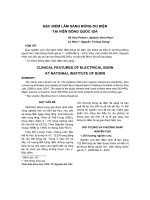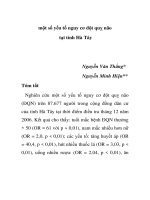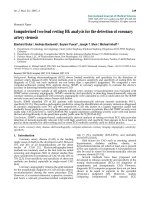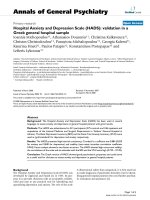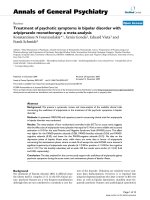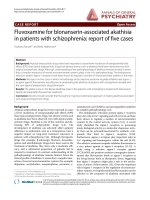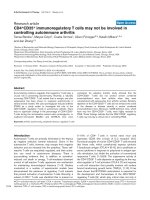Báo cáo y học: "Self-calibrating pulse contour cardiac output: do validation studies really show its clinical reliability" pps
Bạn đang xem bản rút gọn của tài liệu. Xem và tải ngay bản đầy đủ của tài liệu tại đây (40.4 KB, 2 trang )
Available online />Page 1 of 2
(page number not for citation purposes)
Abstract
The present study was performed to test a new software version of
the FloTrac/Vigileo using head-up–head-down tilting in post-
cardiac surgery patients. Impressive improvements in Bland and
Altman limits of agreement from 37.5% to 21.6% were recorded.
The results, however could be attributed to a failure to produce a
wide enough range of test circulatory conditions. A more rigorous
test of performance is needed before any real conclusion concern-
ing use of the FloTrac/Vigileo in clinical practice can be made.
In the current issue Senn and colleagues present their
findings [1] from a study aimed at validating a new version of
the FloTrac/Vigileo monitor (Edward Lifesciences, Irvine, CA,
USA), a system that measures cardiac output using the
arterial pulse contour method.
The pulse contour method is relatively new on the cardiac
output measurement scene. The method was first used
commercially in the Finapres (Ohmedia, Englewood, CO,
USA), a device that used a pneumatic finger cuff to
continuously measure blood pressure. By transforming the
pressure wave into a flow wave, cardiac output was
measured from the area under the flow curve.
In the past few years a number of pulse contour methods
based on the arterial line pressure trace have been developed.
The most well known of these methods are the PiCCO
(Pulsion Medical Systems, Munich, Germany), the LiDCO
(LiDCO Group Plc, London, UK) and the FloTrac/Vigileo.
Until recently these systems have all required prior calibration
using a second method of cardiac output measurement,
either thermodilution (pulmonary artery or transpulmonary) or
lithium dye dilution. The FloTrac/Vigileo has recently
developed a method of self-calibration based on imputing
patient demographic data.
The main concern with all pulse contour systems has been
their failure to properly adjust to changes in circulatory
dynamics, such as blood loss or peripheral vasoconstriction
[2,3]. This failure has lead to more favourable reviews when
these systems have been validated in the relatively stable
haemodynamic setting of postcardiac surgery, but to less
favourable reviews when validated in septic or liver
transplant patients, where the circulatory changes are more
challenging [3].
The points to note about Senn and colleagues’ study are that
updated software (version 1.07) was evaluated, by
comparing 25 patients using the old software (version 1.03)
and 25 patients using the new software (version 1.07).
Comparisons of the FloTrac/Vigileo were also made against
pulse contour and transpulmonary cardiac outputs using the
Pulsion PiCCO system. Three serial changes in cardiac
output were generated by head-up–head-down tilting, and
the trending ability was assessed. Patients were kept
haemodynamically stable throughout the study with
propofol–remifentanil sedation, a pacing wire to control the
heart rate and noradrenaline infusion targeted at a mean
arterial blood pressure of 70 mmHg.
Their data showed a marked improvement in Bland and
Altman limits of agreement between set A data (37.5%) and
set B data (21.6%). The limits for the PiCCO, however, were
equally small (25.5%). There was also a 20% difference in
the reference cardiac output between the sets following the
head-down tilt, as the set A reference output was 6.1 l/min
and the set B reference output was 5.0 l/min. The last
observation is relevant because it suggests the two sets of
patients were haemodynamically different in respect to tilting
responses. Differences in nursing management and the use
of fluids, sedation and noradrenaline in the intensive care unit
could have been responsible for this difference.
The improvement in Bland and Altman limits of agreement
from 37.5% to 21.6% is puzzling. Judged against the
±28.3% acceptable level, the new software version
Commentary
Self-calibrating pulse contour cardiac output: do validation
studies really show its clinical reliability?
Lester AH Critchley
Department of Anaesthesia and Intensive Care, The Chinese University of Hong Kong, Prince of Wales Hospital, Shatin, New Territories, Hong Kong, China
Corresponding author: Lester AH Critchley,
Published: 4 March 2009 Critical Care 2009, 13:123 (doi:10.1186/cc7718)
This article is online at />© 2009 BioMed Central Ltd
See related research by Senn et al., />Critical Care Vol 13 No 2 Critchley
Page 2 of 2
(page number not for citation purposes)
performed very reliably [4] – but so did the PiCCO, with limits
of ±25.5%. The authors attributed this improvement to more
frequent recalibration from 10 minutes to 1 minute. Readings
in the study were taken after 15 minutes of continuous tilt,
however, so recalibration should have occurred with both
software versions. Furthermore, the basic algorithm to adjust
for circulatory changes does not seem to have been modified.
More recent software (version 1.10) still did not cope with the
marked changes in systemic vascular resistance seen in liver
transplant patients [3].
These impressive agreement statistics may reflect experi-
mental design and a failure to generate sufficiently large
changes in haemodynamics to properly test the device. In set
B data the systemic vascular resistance only changed by 5%
(from 960 to 1,008 dyn·s·cm
–5
). Head-up tilting to 30° should
produce at least a 10% to 20% increase in peripheral
resistance in healthy adults [5]. Sedation and controlling the
circulation with noradrenaline may have annulled normal
responses to tilting.
Senn and colleagues’ study does not in my opinion
comprehensively test the FloTrac/Vigileo system as their use
of tilting did not provoke sufficiently large changes in haemo-
dynamics [1]. Little new information can therefore be gained
about the reliability of the FloTrac/Vigileo, other than the new
software only improving reliability by more frequent
recalibration.
The FloTrac/Vigileo system has yet to be shown to cope with
more extreme circulatory conditions. New software versions
need to be rigorously tested in the animal laboratory against a
true reference standard, such as an aortic flow probe, and
need to be shown to track changes in cardiac output reliably
over a range of conditions. Only then should human studies
be performed against thermodilution, using the standard
Bland and Altman approach. Finally, one should not forget
that the clinical utility of the device would still need to be
shown in randomized, clinical controlled trials.
Competing interests
The author declares that they have no competing interests.
References
1. Senn A, Button D, Zollinger A, Hofer CK: Assessment of cardiac
output changes using a modified FloTrac/Vigileo™ algorithm
in cardiac surgery patients. Crit Care 2009, 13:R32.
2. Bein B, Meybohm P, Cavus E, Renner J, Tonner PH, Steinfath M,
Scholz J, Doerges V: The reliability of pulse contour-derived
cardiac output during hemorrhage and after vasopressor
administration. Anesth Analg 2007, 105:107-113.
3. Biancofiore G, Critchley LA, Lee A, Bindi L, Bisà M, Esposito M,
Meacci L, Mozzo R, DeSimone P, Urbani L, Filipponi F: Evaluation
of an uncalibrated arterial pulse contour cardiac output moni-
toring system in cirrhotic patients undergoing liver surgery. Br
J Anaesth 2009, 102:47-54.
4. Critchley LA, Critchley JA: A meta-analysis of studies using
bias and precision statistics to compare cardiac output mea-
surement techniques. J Clin Monit Comput 1999, 15:85-91.
5. Critchley LA, Conway F, Anderson PJ, Tomlinson B, Critchley JA:
Non-invasive continuous arterial pressure, heart rate and
stroke volume measurements during graded head-up tilt in
normal man. Clin Auton Res 1997, 7:97-101.

